The "Trophy Economy". Militarization as a Factor of Industrial Growth
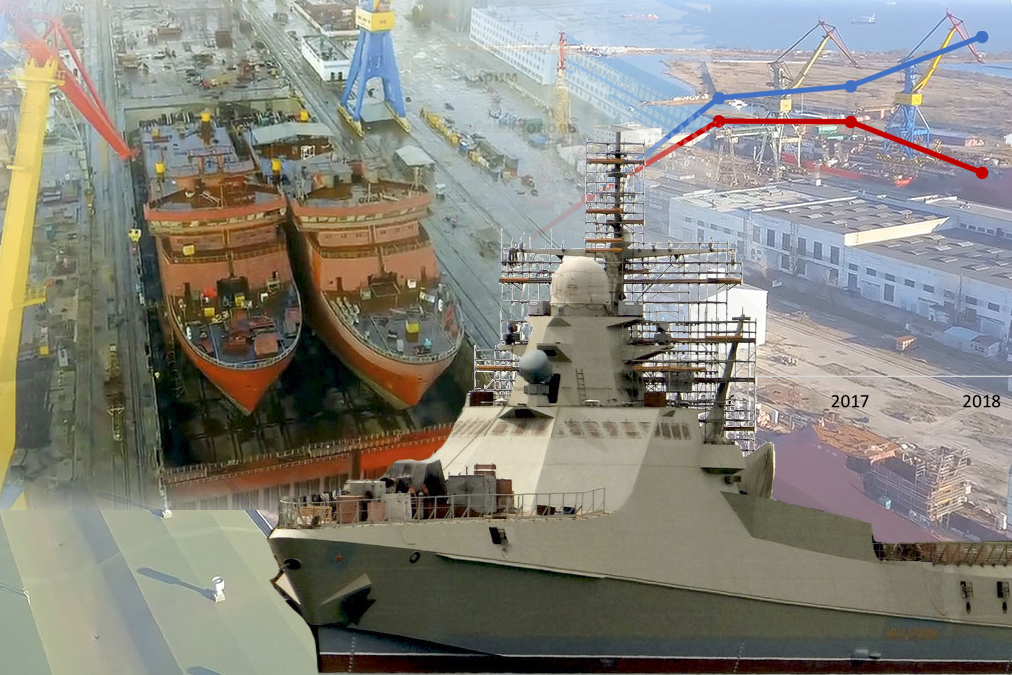
The Monitoring Group of BlackSeaNews
and the Black Sea Institute of Strategic Studies
presents an updated series of articles
«The Socio-Economic Situation in Occupied Crimea in 2014 – 2020»:
Back in the USSR. The Reverse Restructuring of the Crimean Economy
The "Trophy Economy". Militarization as a Factor of Industrial Growth
The "Trophy Economy". The Development of the Stolen Ukrainian Black Sea Shelf
The Commercial Exploitation of Marine Biological Resources
The Crimean "Trophy Economy". The Sale of Ukrainian Property
Occupied Crimea. Exports and Imports in 2014-2020
The Banking System and Investment in Crimea: What is Really Happening on the Occupied Peninsula
Water in Occupied Crimea: No Catastrophe. Just a 50-Year Step Backwards
The Crimean Budget. Small Business. Salaries and Pensions
* * *
As early as 4 April 2014, at an ad-hoc meeting of the Collegium of the Ministry of Defence of the Russian Federation, Defence Minister Sergei Shoigu announced his intention to provide the industry of the occupied peninsula with state defence orders, emphasizing the importance of «using the manufacturing and technological potential of the Crimean defence industry effectively».
In mid-April 2014, Russia’s Kommersant reported that the Ministry of Defence had already compiled the list of 23 Crimean enterprises of interest to the agency. Citing sources in the ministry, the newspaper wrote that «it has been done in line with the directives of President Vladimir Putin and the process is being supervised by Deputy Defence Minister Yuri Borisov. Currently, the proposals on the effective use of the enterprises are being developed».
According to Borisov himself, they «will start working on ensuring the workload for the enterprises after finalizing all the formal procedures, such as licensing and re-registration».
The «formal procedures» the Russian Deputy Defence Minister referred to meant, first and foremost, the expropriation of Ukrainian public and private enterprises. All the peninsula’s defence enterprises were «nationalized» by Russia in the first months of the occupation of Crimea, and most of the state-owned defence enterprises – in the first two weeks.
Almost all Crimean defence companies have already been or are about to be taken over by large Russian corporations, have been leased to Russian enterprises, or at least have so-called «supervisors» in Russia.
The institute of such supervisors was officially introduced in 2016 when the Ministry of Industry and Trade of the Russian Federation ordered that the Crimean enterprises should be assigned supervision. The responsibility of the supervisors has been to share work orders with the Crimean plants they supervise and ensure their modernization.
The official registration of the curatorship by ministerial orders was assigned in August 2017 after another list of the "Crimean" US sanctions. The assets, stolen in Crimea sinсe the occupation have changed a lot: the names of companies have been changed, they have been transferred from one department to another as well as became joint-stock companies etc. Currently, the scheme of changing the ownership due to the "privatization" of assets is getting more popular.
* * *
At year-end 2015, Crimea was declared "the leader in terms of the growth rate of industrial production" in Russia with a growth of 165.5% in Sevastopol in 2014 and 127.2% in Crimea. That growth was mainly due to the provision of Crimean enterprises with military orders.
|
2015 |
2016 |
2017 |
2018 |
|
|---|---|---|---|---|
|
Southern Federal Disctrict |
112,2 |
105,8 |
104,2 |
106,4 |
| Republic of Adygea |
102,5 |
109,9 |
104,2 |
105,5 |
| Republic of Kalmykia |
98,8 |
109,3 |
99,6 |
103,9 |
|
Crimea |
127,2 |
125 |
104,5 |
109,5 |
|
Krasnodar Krai |
102,9 |
103,7 |
104,4 |
105,2 |
| Astrakhan region |
108,7 |
112 |
134,1 |
115 |
| Volgograd region |
102,7 |
102,7 |
103,5 |
101,5 |
|
Rostov region |
153 |
112,2 |
107,1 |
110,4 |
|
Sevastopol |
165,5 |
120,1 |
97,9 |
103,9 |
In April 2016, the then Russian President's envoy in the so-called "Crimean Federal District" Oleg Belaventsev said that the military-industrial complex, which included about 30 companies, was a strategic direction for Crimea's industrial policy.
In 2016, of the eight regions of the Southern Federal District, the highest growth rate of the industrial production was shown by Crimea. Over the course of the year, the output of industrial production in Sevastopol increased by 120.1%.
According to representatives of the Crimean "government", the Crimean enterprises are receiving a sufficient number of state orders mainly due to the personal attention of President Putin and "the firm decision to place a large number of orders at the Crimean shipyards".
However, facing the international sanctions and strong competition from Russian defense companies for state defense orders, it is complicated to achieve the desired level of efficiency in use of Russian occupation of Crimean enterprises.
In October 2019, according to the head of occupation authority of Crimea Sergey Aksenov, the level of loading the machine-building and shipbuilding enterprises in Crimea reached the average of 40%.
* * *
As a result of the occupation, the aggressor acquired 13 Ukrainian defence enterprises, which had been part of the Ukrainian state-owned Ukroboronprom concern, as "war trophies".
At the beginning of 2014, the Ukroboronprom concern included 13 Crimean enterprises, namely:
- Feodosiia Shipyard More;
- the State Enterprise Feodosiiskyi Optychnyi Zavod (Feodosiia Optical Plant);
- PAT Zavod Fiolent (Fiolent Plant), Simferopol;
- the State Enterprise Konstruktorsko-Tekhnolohichne Biuro Sudokompozyt (Sudokompozyt Design and Technology Bureau), Feodosiia;
- the State Enterprise Naukovo-Doslidnyi Instytut Aeropruzhnykh System (Research Institute of Aeroelastic Systems), Feodosiia;
- the State Enterprise Yevpatoriiskyi Aviatsiinyi Remontnyi Zavod (Yevpatoriia Aviation Repair Plant);
- the State Enterprise Sevastopolske Aviatsiine Pidpryiemstvo (Sevastopol Aircraft Enterprise);
- the State Enterprise Skloplastyk, Feodosiia;
- the State Enterprise Feodosiia Ship and Mechanical Plant of the Ministry of Defence of Ukraine
- the State Enterprise Central Design Bureau Chornomorets, Sevastopol;
- the State Enterprise Spetsialna Vyrobnycho-Tekhnichna Baza Polumia (Special Production and Technical Base Polumia), Sevastopol;
- the State Enterprise Research Centre Vertolit, Feodosiia;
- the State Enterprise Konstruktorske Biuro Radiozviazku (Radiocommunications Design Bureau), Sevastopol.
Of those 13, ten enterprises continue operations as separate entities.
By decree 118 dated 28 February 2015, the occupation authorities of Sevastopol «nationalized» Konstruktorske Biuro Radiozviazku and unofficially liquidated it shortly thereafter.
Skloplastyk has become part of Feodosiia Shipyard More, which after corporatization will become part of Kalashnikov Concern.
Sevastopol Central Design Bureau Chornomorets has ceased to exist, having become a design centre within DUP Sevastopolskyi Morskyi Zavod (Sevastopol Shipyard).
* * *
The Monitoring Group of the Black Sea Institute of Strategic Studies and BlackSeaNews has identified 59 Russian companies that collaborate with the seized Crimean enterprises of Ukroboronprom and a total of 149 companies collaborating with the Crimean plants on military production.
Some of the most striking examples of the use of trophy Crimean enterprises are provided below.

February 2020.
Shipyards
Leningrad Shipyard Pella first became a so-called supervisor and then a leaseholder of Feodosiia Shipyard More owned by the state of Ukraine (the city of Feodosiia, the Autonomous Republic of Crimea). After the occupation of Crimea, the More shipyard was seized, expropriated, and "transferred" into the federal ownership of Russia. On 15 November 2016, the More shipyard was leased to Leningrad Shipyard Pella until the end of 2020.
The Russian Pella shipyard has built three new Project 22800 (codenamed Karakurt) inner maritime zone missile corvettes, small-size missile ships according to the Russian classification, at the More shipyard.
Even before the lease of the More shipyard, on 10 May 2016, the Pella shipyard started building Shtorm, the first in a series of 3 missile corvettes of the new Project 22800 Karakurt, for the Black Sea Fleet of the Russian Federation as part of the Russian state defence contract. On 17 March 2017, the shipyard began the construction of Okhotsk, the second missile ship in that series, and on 19 December 2017 – Vikhr, the third corvette.
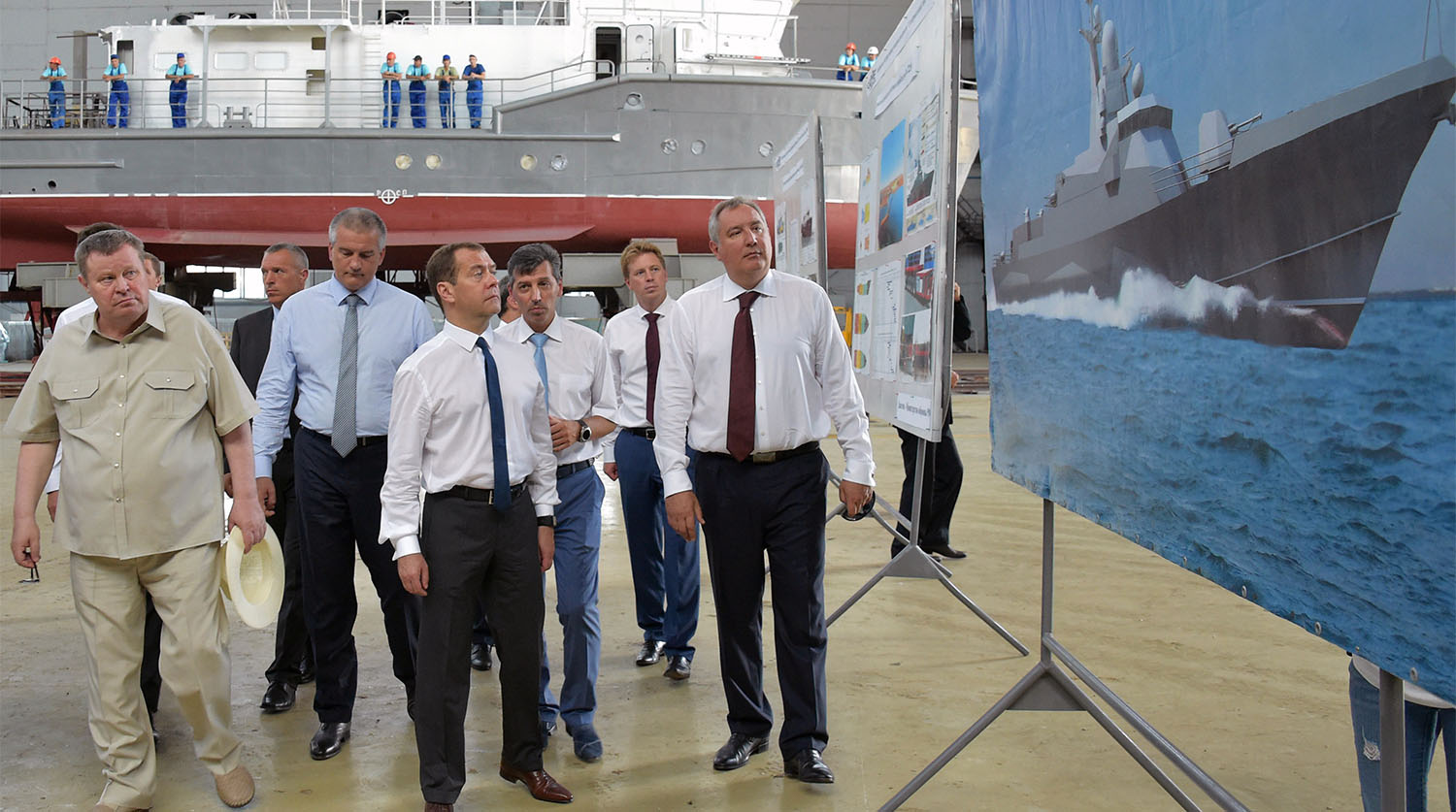
Morye Shipyard in Feodosia on 4 August 2017. Photo by www.gazeta.ru
Following the publication of this information in June 2018, there was a threat of U.S. and EU sanctions against the Pella shipyard. Afterwards, events unfolded as follows.
The first of the three "Feodosiia Karakurts", the Kozelsk small-size missile ship, yard number 254 (during laying down it was named Shtorm), was laid down on 10 May 2016, it was scheduled to be commissioned into the Black Sea Fleet in 2019, and was launched on 9 October 2019 in an unfinished condition.
The Okhotsk small-size missile ship, yard number 255 (during laying down it was named Tsiklon), was laid down on 17 March 2017. It was scheduled to be commissioned into the Black Sea Fleet in 2019 and was launched on 29 October 2019.
The Vikhr small-size missile ship, yard number 256 (the name was given during laying down and so far has not been changed), was laid down on 19 December 2017, launched on 13 November 2019.
After that, in order to avoid international sanctions, Leningrad Shipyard Pella decided to suspend the construction of the three missile corvettes of the Karakurt Project immediately, a year before the lease term expired. It launched unfinished hulls of varying degrees of readiness and organised their towing to the Pella shipyard.
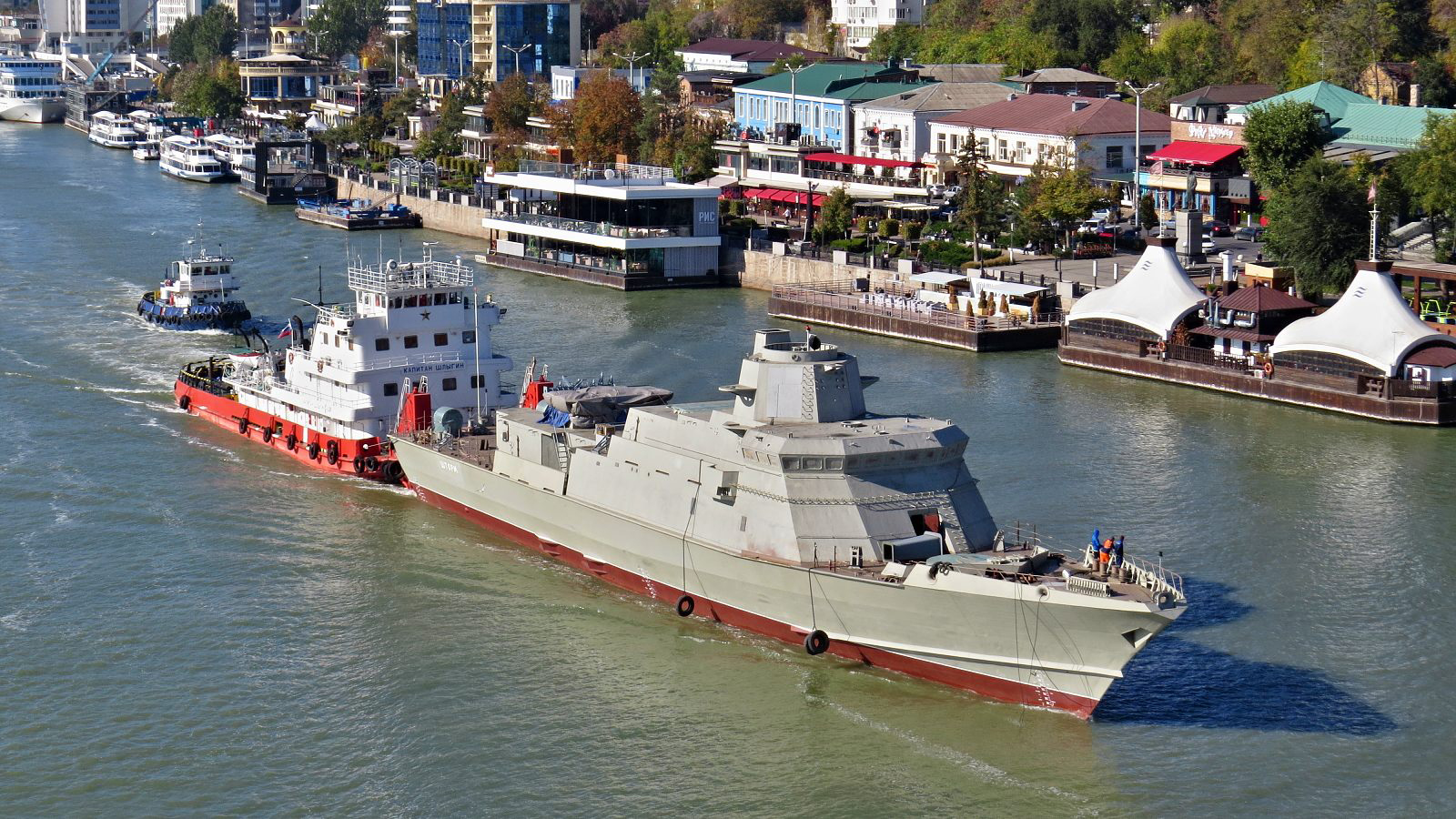
21 October 2019. Photo from the BlackSeaNews archive
Towing of the 2nd and 3rd ships began at the moment it was already clear that they could not be transported to the Leningrad region before the closure of navigation on the inland Russian waterways (usually navigation stops in mid-November).
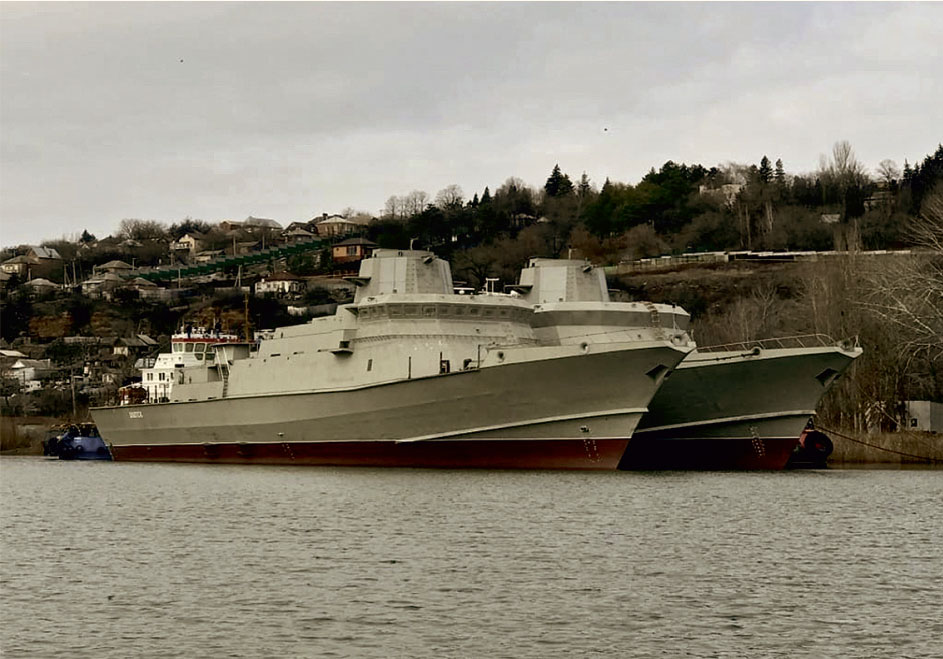
AO Zelenodolskiy Zavod Imeni A. M. Gorkogo (Zelenodolsk Shipyard Plant, named after A.M. Gorky), based in the Republic of Tatarstan, part of the AO Ak Bars Holding company, is one of the largest ship manufacturers in Russia.
Zelenodolsk Shipyard Plant’s main «success» on the peninsula is its illegal seizure of the property of the Zaliv shipyard in Kerch in August 2014.
It should be pointed out that Zaliv has one of the largest shipbuilding docks in Europe. Being 364 metres long and 60 metres wide, the dock has no equivalents in the RF. Therefore, we anticipate that its use for the needs of the Russian military will continue to grow.
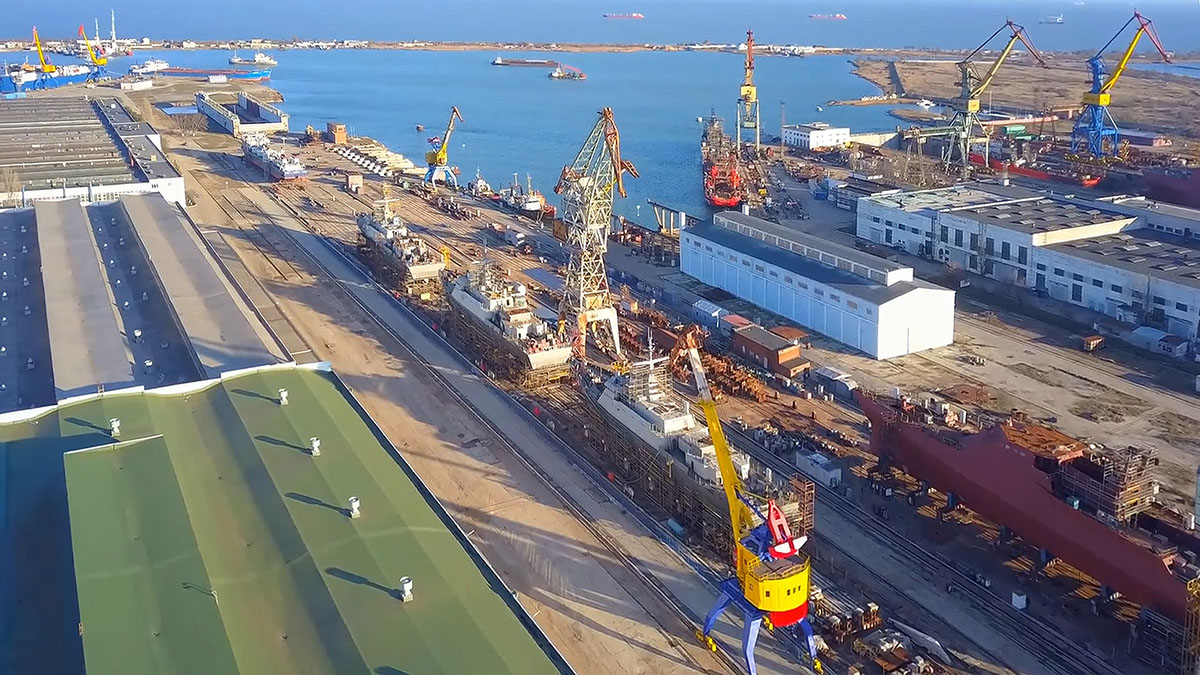
Photo from the BlackSeaNews archive, February 2020.
As of 1 October 2020, the programme to construct warships for the Black Sea Fleet of the RF at the Zaliv shipyard as part of the Zelenodolsk Shipyard Plant’s state defence order is as follows.
Three off-shore maritime zone missile corvettes of Project 22160:
- the main ship of this project, Vasily Bykov, was laid down on 26 February 2014 in Zelenodolsk, launched in August 2017. In November 2017, it was towed for completion at the Zaliv shipyard. The construction was completed in March 2018. On 25 March 2018, it headed from Kerch to Novorossiysk for state testing. In December 2018, it was commissioned into the Black Sea Fleet of the RF;
- the missile corvette Pavel Derzhavin was laid down on 18 February 2016; launched on 21 February 2019. In April 2019, it arrived in Novorossiysk from Kerch for state testing; the commissioning into the Black Sea Fleet of the RF is scheduled for 2020. It has become the first warship to be built entirely at the Zaliv shipyard;
- the missile corvette Sergey Kotov was laid down on 8 May 2016. It is currently under construction. Its launch scheduled for 2019 didn’t take place, the deadline for the completion of construction in 2020 will also be missed.
The construction of the three missile corvettes of Project 22800 Karakurt
- the Tsiklon corvette was laid down on 26 July 2016; launched on 24 July 2020. The deadline for the construction completion in 2019 was missed;
- the Askold corvette was laid down on 18 November 2016; is currently under construction on open slipways, the deadline for the construction completion in 2019 was missed;
- the Amur corvette was laid down on 30 July 2017; is currently under construction on open slipways, the deadline for the construction completion in 2020 was missed.
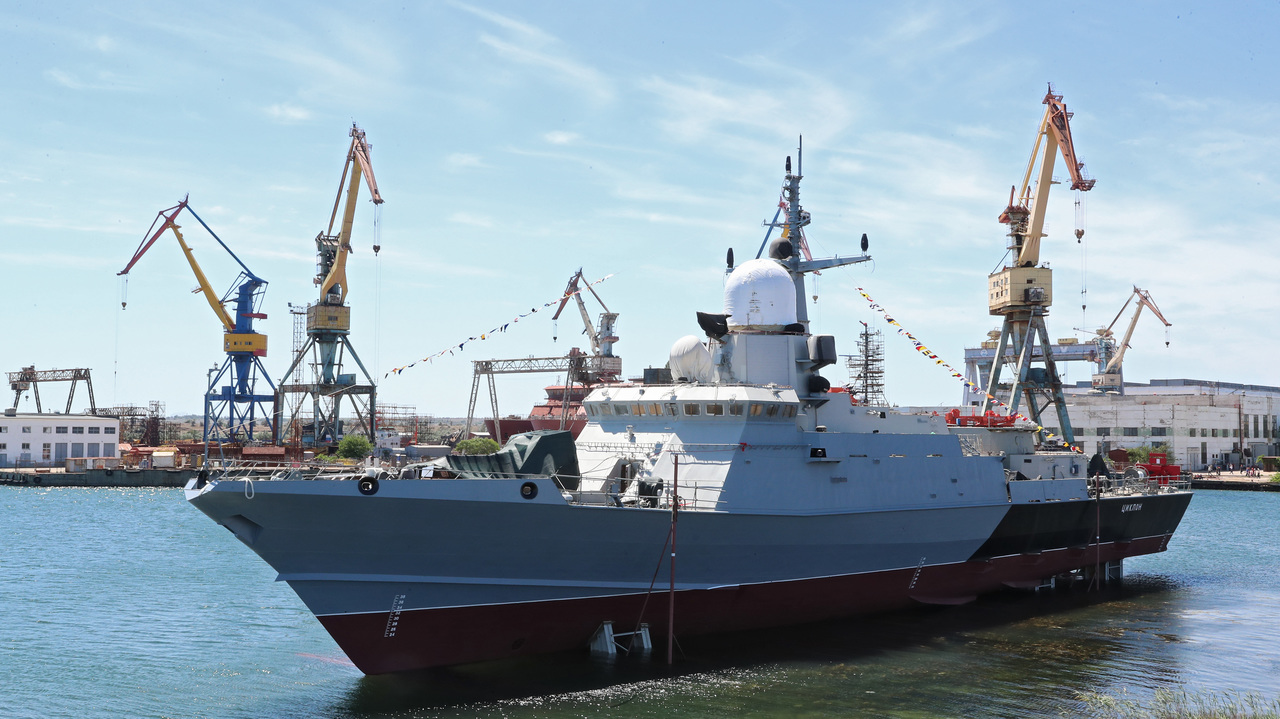
The construction of naval cable ships of Project 15310 codenamed Kabel
Cable layers and ice-breaking vessels Volga and Vyatka of Project 15310 were laid down on 6 January 2015; launched on 18 August 2020. They have a displacement of over 10,000 tonnes, a deadweight of 8,000 tonnes, a length of 140 metres, and a width of 19 metres. Their purpose is laying marine communications cables, wiretapping or damaging international submarine cables, including in Arctic waters. Contract deadlines for the completion of construction in 2018 and 2019 were missed.
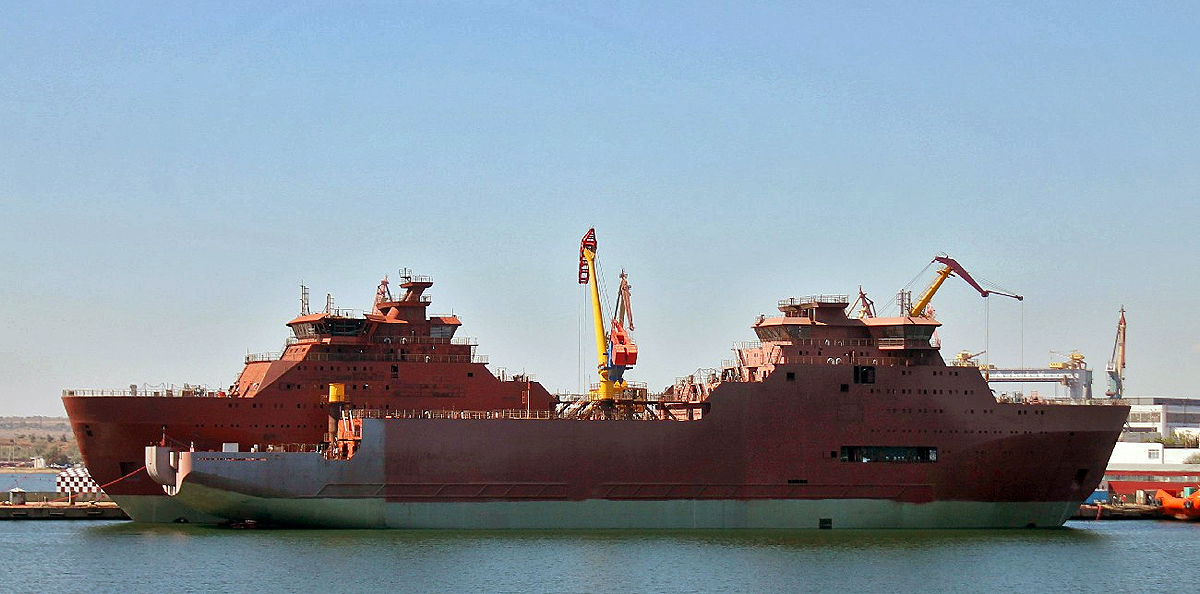
The construction of two military oil tankers (supply ships) of Project 23131
Their purpose is receiving, storing, transporting, and transferring liquid (diesel fuel, motor oil, water) and dry cargoes (food, equipment, weapons) to ships. The length of one such ship is 145 m, width – 24 m, water draught – 7 m, speed – 16 knots, deadweight – 12,000 tonnes, navigation area – unlimited, cruising endurance – 8000 miles. The ships were laid down on 26 December 2014, the deadlines for construction completion in 2017-2018 were missed due to Western sanctions. The formation of the ships' hulls and superstructures has been completed, the preparation of the hulls for electrical installation work is currently underway.
The construction of amphibious assault ships of Project 23900
On 20 July 2020, for the first time in the history of the Russian Navy, the two helicopter-carrying amphibious assault ships of Project 23900, Ivan Rogov and Mitrofan Moskalenko (yard numbers 01901 and 01902), were laid down at the seized Zaliv shipyard with the participation of the President of the Russian Federation.
The operational characteristics and even the general appearance of these ships are classified. It is known that one such ship will carry on board more than 20 heavy-lift helicopters, as well as ship-based unmanned combat aerial vehicles and reconnaissance UAVs, will have a well dock for landing craft utilities and will be able to carry about 1000 marines and 75 armoured fighting vehicles. Its displacement is up to 30,000 tonnes, length – over 220 m. The cost of one such ship is 40 billion roubles.
The commissioning of the first amphibious assault ship into the Russian Fleet is scheduled for 2025, the second – for 2027.
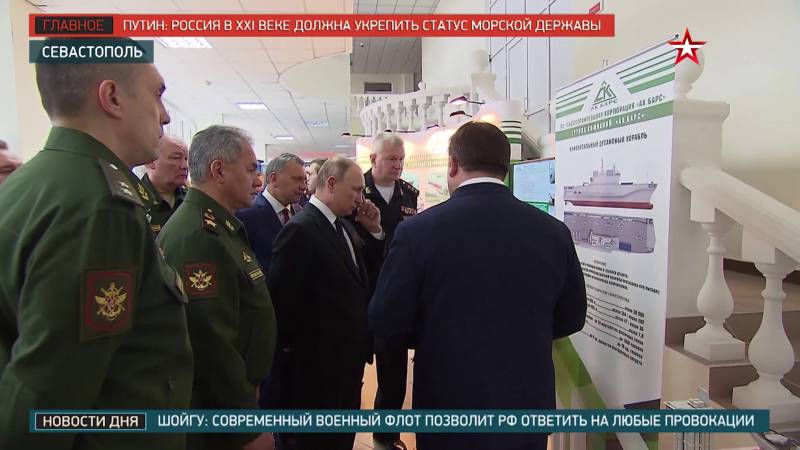
The related companies in this project will have to cooperate with the two plants that are already under international sanctions, including the U.S. sanctions. The construction of warships of this class will require cooperation with hundreds of plants in Russia.
The construction of other ships:
- three small hydrographic survey vessels of Project 19910 for the Black Sea Fleet of the RF were laid down on 26 July 2016, 18 November 2016, and 30 June 2017;
- the rescue vessel Spasatel Ilyin of Project MPSV07 for the Ministry of Emergency Situations of the RF was laid down on 28 July 2015 and launched on 21 February 2019. It is being completed at the dockside of the Zaliv shipyard; the construction completion is scheduled for 2020;
- passenger-and-freight auto ferry of Project CNF22 was laid down on 16 March 2020; its cost is 3.1 billion roubles; the construction completion is scheduled for December 2021. The customer is Rosmorrechflot for Kamchattransflot (regular transportation between Kamchatka and Vladivostok; 150 passengers, cars and trucks, buses, wheeled and tracked vehicles, 20-foot and 40-foot containers).
* * *
Aircraft-Building Enterprises
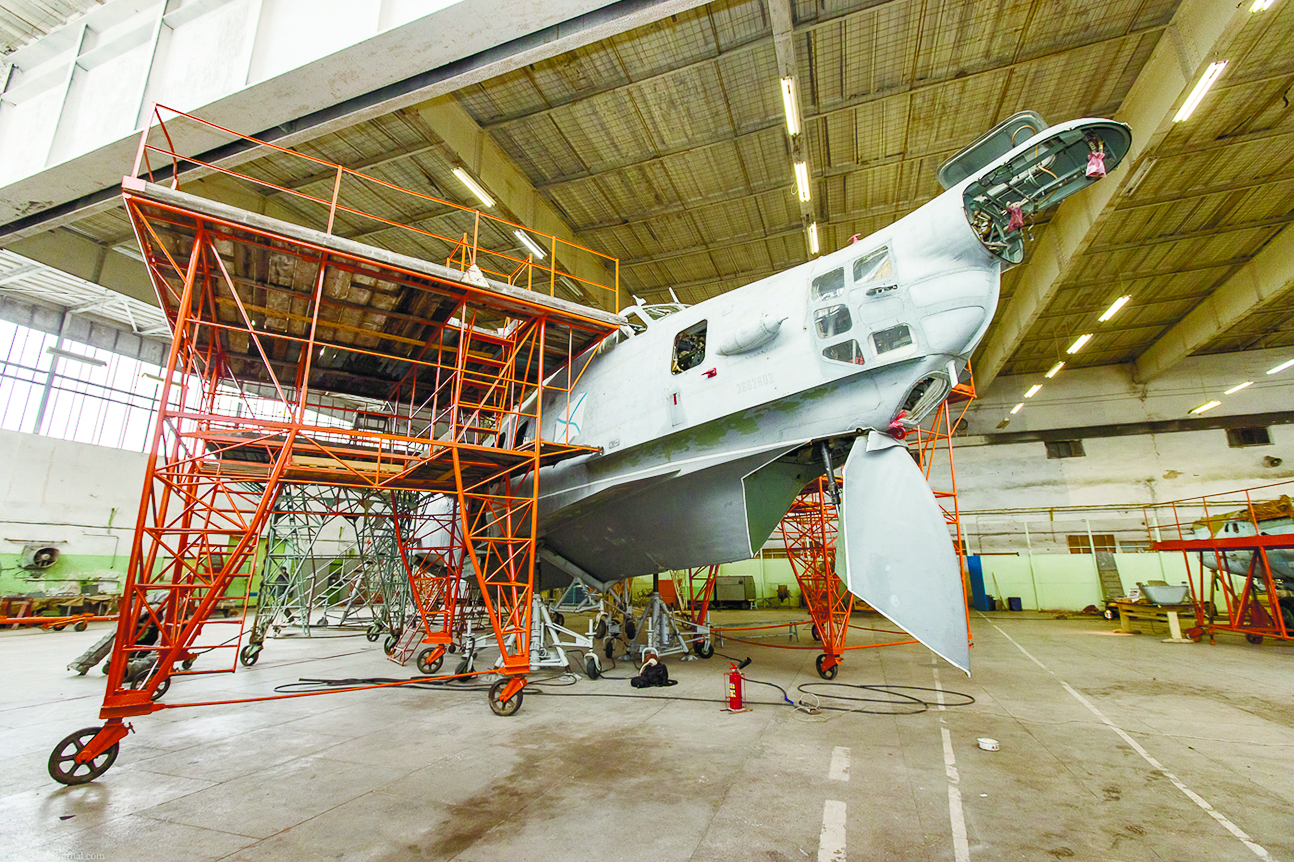
PAO Obedinennaya Aviastroiitelnaya Korporatsiya (United Aircraft Corporation), Moscow. It is on the Ukrainian and EU sanctions lists. By the orders of the Ministry of Industry and Trade of the RF, Obedinennaya Aviastroiitelnaya Korporatsiya has been officially assigned to DUP RK Yevpatoriiskyi Aviatsiinyi Remontnyi Zavod (Yevpatoriia Aviation Repair Plant) in order to provide the latter with orders. After corporatization, Yevpatoriiskyi Aviatsiinyi Remontnyi Zavod will become part of Obedinennaya Aviastroiitelnaya Korporatsiya.
AO Vertolety Rossii (Russian Helicopters), Moscow, part of Rostec. The company is on the Ukrainian and U.S. sanctions lists.
By the orders of the Ministry of Industry and Trade of the RF, Vertolety Rossii has been officially assigned to Sevastopolske Aviatsiine Pidpryiemstvo (Sevastopol Aircraft Plant) in order to provide the latter with orders. FGUP Syevastopolskoye Aviatsionnoye Pryedpriyatiye is de-facto integrated into the Vertolety Rossii holding.
AO Tekhnodinamika, Moscow, part of Rostec. The company is on the Ukrainian and U.S. sanctions lists. It is a leading Russian developer and manufacturer of aircraft equipment, including landing gear, fuel and flight control systems, and auxiliary power units.
Tekhnodinamika has been assigned to Naukovo-Doslidnyi Instytut Aeropruzhnykh System in order to provide the latter with orders. After the corporatization of the State Enterprise Naukovo-Doslidnyi Instytut Aeropruzhnykh System, the company will become part of AO Tekhnodinamika.
PAO Taganrogskiy Aviatsionnyy Nauchno-Tekhnicheskiy Kompleks Imeni G. M. Berieva (Taganrog Aviation Scientific-Technical Complex named after G.M. Beriev), Taganrog. The company develops and manufactures aviation equipment, part of PAO Obedinennaya Aviastroiitelnaya Korporatsiya. The seized Yevpatoriiskyi Aviatsiinyi Remontnyi Zavod repairs Be-12 aircraft produced by PAO Taganrogskiy Aviatsionnyy Nauchno-Tekhnicheskiy Kompleks Imeni G. M. Berieva that oversees the quality of repairs.
Russian Navy Be-12 aircraft at Yevpatoriiskyi Aviatsiinyi Remontnyi Zavod
AO 121 Aviatsionnyy Remontnyy Zavod (121 Aircraft Repair Plant) is a leading enterprise in repair and modernization of tactical aviation aircraft and engines. The company is part of PAO Obedinennaya Aviastroiitelnaya Korporatsiya. A separate business unit of 121 Aviatsionnyy Remontnyy Zavod, Service Centre Saki, has been set up on the premises of Yevpatoriiskyi Aviatsiinyi Remontnyi Zavod in Novofedorivka.
However, not all trophy enterprises of Ukroboronprom in Crimea will be used by the Russian military-industrial complex. Some of them, which have equivalents in the Russian Federation, such as Feodosiiskyi Optychnyi Zavod, are likely to be liquidated.
* * *

This article has been published with the support of ZMINA
Human Rights Centre. The content of the article is the sole responsibility of the authors.
More on the topic
- 21.08.2023 Peculiarities of the 2023 Crimean Holiday Season — a «Tourism» in Camouflage
- 06.08.2023 Crimea During the Great War. Part 2. Extreme Tourism or «New Types of Tourism» and Tourist Numbers (2)
- 21.07.2023 Crimean Titan: Under a Russian Holding or a Ukrainian Tank?
- 12.06.2023 Crimea during the Great War. The situation in the occupied Crimea in 2022-2023. Military Context (1)
- 23.11.2021 Occupied Crimea. Exports and Imports / 2014-2021
- 23.11.2021 Water in Occupied Crimea / 2014-2021
- 23.11.2021 The Crimean Budget. Small Business. Salaries and Pensions / 2014-2021
- 23.11.2021 The "Trophy Economy". The Commercial Exploitation of Marine Biological Resources in the Black Sea and the Sea of Azov / 2014–2021
- 21.11.2021 The "Trophy Economy". Militarization as a Factor of Industrial Growth / 2014-2021
- 21.11.2021 Back in the USSR. The Reverse Restructuring of the Crimean Economy / 2014-2021
- 20.11.2021 The "Trophy Economy". The Development of the Stolen Ukrainian Black Sea Shelf / 2014-2021
- 20.11.2021 The Occupied Crimean Tourism / 2014-2021